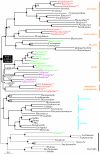Phylogenomics reveals a new 'megagroup' including most photosynthetic eukaryotes
- PMID: 18522922
- PMCID: PMC2610160
- DOI: 10.1098/rsbl.2008.0224
Phylogenomics reveals a new 'megagroup' including most photosynthetic eukaryotes
Abstract
Advances in molecular phylogeny of eukaryotes have suggested a tree composed of a small number of supergroups. Phylogenomics recently established the relationships between some of these large assemblages, yet the deepest nodes are still unresolved. Here, we investigate early evolution among the major eukaryotic supergroups using the broadest multigene dataset to date (65 species, 135 genes). Our analyses provide strong support for the clustering of plants, chromalveolates, rhizarians, haptophytes and cryptomonads, thus linking nearly all photosynthetic lineages and raising the question of a possible unique origin of plastids. At its deepest level, the tree of eukaryotes now receives strong support for two monophyletic megagroups comprising most of the eukaryotic diversity.
Figures

References
-
- Andersson J.O, Roger A.J. A cyanobacterial gene in nonphotosynthetic protists—an early chloroplast acquisition in eukaryotes? Curr. Biol. 2002;12:115–119. doi:10.1016/S0960-9822(01)00649-2 - DOI - PubMed
-
- Arisue N, Hasegawa M, Hashimoto T. Root of the eukaryota tree as inferred from combined maximum likelihood analyses of multiple molecular sequence data. Mol. Biol. Evol. 2005;22:409–420. doi:10.1093/molbev/msi023 - DOI - PubMed
-
- Bhattacharya D, Archibald J.M, Weber A.P, Reyes-Prieto A. How do endosymbionts become organelles? Understanding early events in plastid evolution. Bioessays. 2007;29:1239–1246. doi:10.1002/bies.20671 - DOI - PubMed
-
- Burki F, Shalchian-Tabrizi K, Minge M, Skjaeveland A, Nikolaev S.I, Jakobsen K.S, Pawlowski J. Phylogenomics reshuffles the eukaryotic supergroups. PLoS One. 2007;2:e790. doi:10.1371/journal.pone.0000790 - DOI - PMC - PubMed
-
- Cavalier-Smith T. The phagotrophic origin of eukaryotes and phylogenetic classification of Protozoa. Int. J. Syst. Evol. Microbiol. 2002;52:297–354. - PubMed
Publication types
MeSH terms
LinkOut - more resources
Full Text Sources
Other Literature Sources
